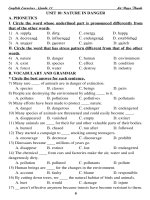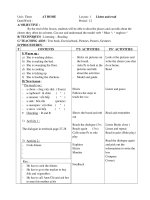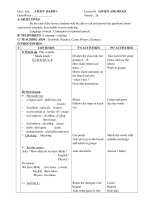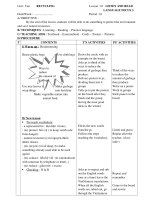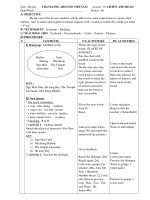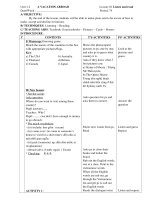E 8 UNIT 10
Bạn đang xem bản rút gọn của tài liệu. Xem và tải ngay bản đầy đủ của tài liệu tại đây (80.13 KB, 12 trang )
Unit : Ten RECYCLING Lesson : 01 LISTEN AND READ
LANGUAGE FOCUS 3
Date/Week : …………………………….. Period : 61
A/ OBJECTIVE :
By the end of the lesson, students will be able to do something to protect the environment
and save natural resources.
B/ TECHNIQUES : Listening – Reading – Practice language.
C/ TEACHING AIDS : Textbook – Exercisebook – Cards – Posters – Pictures
D/ PROCEDURE :
T CONTENTS T’S ACTIVITIES PS’ ACTIVITIES
I/ Warm up : Brainstorming
Reuse plastic bags Use cloth bags
Use tree leaves to Make garbage
wrap things into fertilizer
Make vegetable matter into
animal food.
II/ New lesson:
• Pre teach vocabulary :
- a representative : đại diện (trans)
- (to) protect: bảo vệ ( to keep so/sth safe
from danger).
- natural resource(s); tài nguyên thiên nhiên
(trans).
- (to) recycle: tái sử dụng (to make
something already used able to be used
again)
- (to) contact : liên hệ với (to communicate
with someone by telephone or letter…)
- (to) reduce : giảm bớt ( exam)
• Checking : R & R
Draws the circle with an
example on the board.
Asks ps to think of the
ways to reduce the
amount of garbage they
produce.
Delivers posters to ps ,
dividing them into 4
groups
Tells ps to put the posters
on the board after they
finish and the group
having the most good
ideas is the winner.
Elicits the new words
from the ps
Follows the steps teaching
the vocabulary.
Asks ps to repeat and rub
out the English words
(one at a time) leave the
VietNamese translations.
When all the English
words are rubed out, go
through the Vietnamese
Think of the ways
to reduce the
amount of garbage
they produce.
Write on a poster
Work in groups
Stick poster on the
board.
Listen and guess
Repeat after the
teacher. (class-
indiv)
Repeat and
remember
Come to the board
and rewite
Ways to
reduce
the amount of
garbage
Ways to
reduce
the amount of
garbage
• Set the scene :
A representative from Friends of the
Earth, Miss Blake, is talking to the
students of Quang Trung School.
Friends of the Earth shows people how
to protect the environment and save
natural resources.
1) Activity 1 :
Practice the dialogue with a partner. One of
you is Miss. Blake. The other plays the
roles of Ba, Hoa, Lan
2) Activity 2 :
Answer the questions on page 90.
Key :
a) Reduce means not buying products
which are overpackaged.
b) We can reuse things like envelopes,
glass and plastic bottles and old plastic
bags
c) Recycle means don’t just throw things
away. Try and find another use for
them.
d) We can look for information on
recycling things by having contact with
an organization like Friends of the
Earth, going to the local library, or
asking your family and friends.
e) We shouldn’t use plastic bags because
when we throw them away, they could
stay very long and could not be self-
destroyed/ self demolished.
3) LANGUAGE CONTENT :
* Form :
It + be + Adjective + to infinitive
Ex: It’s difficult to follow your directions
(Thật khó để theo sự hướng dẩn của bạn)
• Practice :
Complete the dialogues. Use the words in
list and get the ps to call
out the English words
Reads the dialogue (2ts)
Read again (2ts)
Calls some groups four to
practice the dialogue
(open pairs)
Number the ps and asks
them to practice the
dialogue (close pairs)
Calls four ps at a time to
practice the dialogue.
Asks ps to look at the
dialogue silently and find
out the answer
Calls some pairs to
practice ask and answer
Explains the structure;
Form; Use; Meaning..
Asks ps to open book
page 96 Exercise 3.
Runs through the
meaning.
Listen
Listen and repeat
Whole class.
Practice in groups
four
(open practice)
Practice the
dialogue (close
practice)
Look at the
dialogue and find
out the answer
Work in
individuallly
Compare
Practice in pairs
(role play)
Open books and
complete the
dialogue.
Practice the
the box. Exercise 3 – Textbook – Page 96
Key :
1) It’s easy to understand.
2) It’s hard to believe
3) It’s dangerous to go near the stove.
4) It’s important to wait for five minutes..
III/ Homework:
Prepare the new lesson.
Do exercises 7 – 8 in workbook on page 63
Exercise 7:
Key
a) It is lovely to see you again.
b) I am delightful (thú vò) to receive your
message.
c) They are well prepare to attend the
Olympia contest.
d) He is anxious to wait for the test results
e) We are happy to receive a lot of
presents from our grandparents
f) She is smart enough to answer all the
questions.
Exercise 8:
Key:
a) I am happy to pass all exams
b) We are ready to clean the environment
c) It is difficult to keep people from
littering (Thật khó để giữ mọi người vứt
rác ra đường phố).
Asks ps to complete the
dialogue
Calls on some pairs to
demonstrate the dialogue
Asks ps to do and write
them on notebook at
home
dialogue in pairs
(role play)
Unit : Ten RECYCLING Lesson : 02 - SPEAK
- LISTEN
Date/Week : …………………………………… Period : 62
A/ OBJECTIVE :
By the end of the lesson, students will be able to respond to instructions and listen for
specific information about making compost.
B/ TECHNIQUES : Speaking – Listening.
C/ TEACHING AIDS : Textbook – Pictures – Cards – Posters.
D/ PROCEDURE :
T CONTENTS T’S ACTIVITIES PS’ ACTIVITIES
I/ Warm up : Kim’s game
Used paper, old newspapers, books,
cardboard, boxes, bottles, glasses, jars,
plastic bags, food cans, drinking tins,
vegertable matter, clothes, shoes, school
bags,…………………………….
II/ New lesson :
• Pre teach vocabulary :
- Fertilizer (n) phân bón (explan)
(to) fertilize: bón phân
- Compost (n) : phân xanh
a compost heap : một đống phân xanh.
- fabric (n) sợi vải (Exam)
- leather (n) da ( Exam)
• checking : R & R
1) Pre speaking : Arrangement
Look at the picture and decide which group
each item belong to (page 90 – Textbook)
There are seven groups:
- Paper: paper, old or used newspaper,
books, notebook, cardboard boxes, paper
flowers….
- Glass : bottle, glasses, mirrors, jars,….
- Plastic : Plastic bags, plastic bottles,
plastic wares, plastic combs…..
- Meta l : food cans, drinking cans, tins…
- Vegetable matter : fruit peels,
Shows the pictuer to the
ps and ask them to
observe it carefully, let
them look at the picture
for about 20"”then put it
away.
Divides the class into
two groups.
Asks ps (one pupil in
each team at a time) to
go to the board and write
as many words showing
things in the picture as
possible.
Which group writes the
most right words is
winner.
Elicits thr new words
from the ps
Follows the steps
teaching the new words
Asks ps to look at the
picture and arrange the
things on it which group
each item belong to
Elicits 7 groups on the
box.
Divides the class into
four groups. Each group
find two kinds of things
(Ex: G1: Paper – Glass;
G2: Plastic – metal….)
Look at the picture
and remember the
thing on it
Come to the board
and write.
Work in groups.
Listen and guess
Repeat after the
teacher (class/indiv)
Repeat and
remember
Look at the picture
and arrange
Work in groups
Stick their posters on
the board
Correct
vegetables,……….
- Fabric : clothes, pieces of materials….
- Leather : shoes, sandals, school bags…..
2) While speaking :
* Which group do ………….belong to?
- Put them in……………………..
* What can we do with…………………..? / What
will we do with it ?
- We can recycle them and make them
into………………………………………….
3) Post listening :
You will hear four questions during the
recording. Check (V) the correct answers.
Listening text:
a. What type of garbage can you put in the
compost?
Today I’m going to explain how to start
a compost heap. First of all, you must
use only vegetable matter includes tea
leaves,egg shells – but wash the shells
first – and tissues. Don’t use any meat
or grain products because thic attracts
rats.
b. Where is the best place for a compost
heap?
Find a place in yourgarden that gets a few
hours of sunlight each day. Use pick or
shovels to turn the compost regularly so it
gets plenty of air.
c. Should you water the compost?
The compost also needs moisture, but it will
get this from condensation. Cover the heap
with a sheet of strong plastic if the weather
is very wet.
d. How long does it take before you can
use the compost?
Keep adding to the pile and after about six
months, your compost will be ready to use
as fertilizer.
Key:
a) A b) B c)A d) B
III/ Homework:
Prepare the new lesson
Practice the dialogue with your partner
replacing the information
Model some things
Asks ps following the
sentences on page 91
and the chart to practice
speaking ask and answer
Elicits – Helps.-
Encourages them to
speak
Asks ps to look at four
questions on page 91
Asks ps to listen to the
tape and choose the
correct answers, tick
them.
Read the listening text
(2ts) . Can emphasize
the key words
Moisture: hôi aåm
Condensation: khoái coâ
ñaëc
Give feedback
Look at the posters
on the board and the
sentences on page
91 to practice
speaking ask and
answer
Work in pairs
Look at the book on
page 91
Run through the
meaning
Listen and tick
Corect
